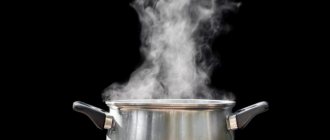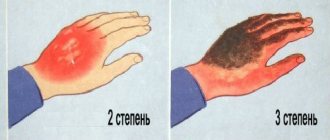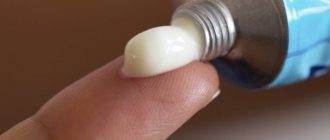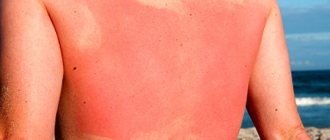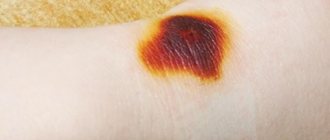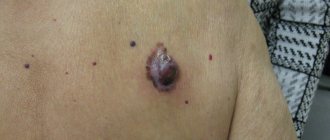Most often, injuries occur while performing normal daily activities. One of the most common household injuries is thermal burnwhich occurs due to careless use of the iron. This can occur as a result of accidental contact with the surface of the device, contact with a hot stream of steam on the skin, or, much less frequently, exposure to electric current.
Photo 1. Not only children, but also adults should handle the iron carefully. Source: Flickr (Harald Mühlhoff).
Burn severity
The degree of burn from the iron must be determined immediately. Since the provision of first aid largely depends on this.
- The first degree is minor damage to the skin. Redness, slight swelling and swelling are noticeable. The skin may experience peeling or burning.
- The second degree is characterized by all of the above symptoms, but they are accompanied by the appearance of watery formations of various sizes.
- Third degree - deep burn, tissue death on the affected area of skin is noticeable.
Victims often suffer first and second degree injuries. The third stage is the most dangerous and is rare.
https://youtu.be/jQrXDaHN11I
Steam burn
You can get a burn not only after contact with the heated surface of the iron; hot steam can also severely burn the skin. It is important to understand the severity of steam injuries.
Only by this indicator can you find an effective way to treat a burn.
So, a steam burn is classified into the following degrees of severity:
- 1st degree – redness in the damaged area of the skin, swelling, pain. However, such a burn disappears on its own after 4-5 days.
- 2nd degree - blisters appear on the affected skin, inside of which there is plasma liquid. There is swelling and severe redness. This burn usually disappears after 2-3 weeks.
- 3rd degree - muscles are damaged, as heated substances during a burn enter the skin tissue. After which blisters appear, then they burst. In their place, damage forms. The healing period is quite long, since there is an open wound on the hand. Due to sluggish healing, suppuration may appear.
- Grade 4 is characterized by serious damage to the skin - charring. Such a steam burn should only be treated in a hospital and under the supervision of a doctor.
The most dangerous degrees of steam burn are the third and fourth. According to statistics, if the area of skin damage is about 10%, then the person is sent for specialized treatment to a hospital.
What to do if you are burned by an iron from steam yourself? First of all, don't panic. Secondly, you should adhere to a strict procedure:
- “Clean” the damaged area of skin from jewelry, clothing, watches, etc. If necessary, use scissors to avoid further damaging the skin.
- Cool burn-damaged skin. Turn on the cold water tap and run the scalded area under the running water for about 10-20 minutes.
An alternative to cooling is ice if there is no water nearby. However, the ice should be kept for no more than 5 minutes. Otherwise, ice can aggravate the skin condition by deadening epidermal cells.
- Be sure to treat the wound with an anti-inflammatory agent. For example, potassium permanganate is often used as an antiseptic to disinfect wounds. To prepare the solution you will need 1 g of product and 150 g of water. Mix thoroughly and strain the resulting mixture through gauze. If this is not done, then crystals from manganese may get into the wound, and accordingly, the affected area from the burn will increase. If you are afraid to use this remedy, skip this step.
- Treat the burn with a healing ointment, such as Olazol.
- Afterwards you need to apply a bandage. Use a sterile bandage.
Under no circumstances should you lubricate a burn with oil or cream. These products create a barrier to heat escape. Accordingly, the wound will take a very long time to heal.
What to do in case of an iron burn at home, alternative medicine recipes
The following folk remedies are considered effective in the treatment of first-degree burns; more severe injuries cannot be treated with similar methods:
- A good result is achieved by grinding aloe into a paste and anointing it with a natural preparation 3 times a day.
- A folk remedy for iron burns is tomato paste. It will help relieve pain, swelling and redness. It should be applied after proper first aid.
- A popular remedy used when people suffer thermal injuries from an iron to eliminate painful symptoms is a raw chicken egg. For minor injuries, it is recommended to use whipped egg white and spread the mixture onto the damaged area. Leave on the skin until it dries and peels off on its own. For greater effectiveness, apply 3-5 times a day.
- First aid at home for iron burns is raw potatoes. Tubers help effectively eliminate symptoms. Using a fine grater, get potato pulp, add 1/2 tsp. honey, can be applied under a sterile bandage for 2 hours. Repeat the procedure 2 times a day.
- Black cumin oil-based extract will help in treatment, prevent the formation of scar tissue, and relieve pain symptoms. It is necessary to smear the wound with oil 4-5 times a day, but only after the burned tissue has completely cooled. It can be used in its pure form or effectively combined with St. John's wort oil.
- You can also apply toothpaste to an iron burn at home. It effectively eliminates the symptoms of thermal damage and should be applied in a thin layer. For household burns, it is good if mint and propolis are one of the components.
- For complex injuries with the formation of blisters, chamomile infusion is effective. Rinse the damaged area 3 times a day; it has anti-inflammatory and antiseptic properties.
- If you are burned by an iron at home, it is recommended to make a compress from a cabbage leaf, this will help eliminate redness and swelling.
- A decoction of oak bark has healing and antibacterial properties. Pour 1 tbsp. raw materials with 1 glass of boiling water, leave and rinse 4-5 times a day to heal the wound.
Avoid questionable recipes for treating thermal injuries, for example, the use of kerosene, gasoline, vinegar. This can aggravate the situation and lead to serious complications.
After first aid for an iron burn has been provided, you should consult a doctor to prescribe effective therapy and accurately diagnose the extent and area of damage. Only a good specialist knows better how to treat iron burns at home.
Iron burn to finger
A finger burn is an equally serious injury in which a limb is damaged superficially or deeply by a hot object. Often a finger burn occurs as a result of contact with a hot kettle, soldering iron, stove, steam, curling iron or iron.
What to do if your finger is burned by an iron? Specific steps for first aid:
- cool the damaged skin under running cold water for 10-20 minutes;
- then gently blot with a napkin to dry;
- disinfect the wound with a weak manganese solution or medical alcohol.
If a blister forms at the site of the burn, under no circumstances should it be burst. Apply a bandage, and within 4-5 days the liquid inside the blister will resolve itself.
Causes of iron stains
They arise from improper handling of an electrical appliance. The iron, which is turned on for a long time, overheats and leaves stains when it comes into contact with the fabric. Modern devices are equipped with a regulator, so when ironing you should take into account the type of fabric and set the desired temperature. The power of the device also matters. If it is small, then the iron heats up slowly. When power consumption is high, this happens in a matter of minutes.
Burnt stains most often appear on fabrics that contain synthetic fibers. They often remain on items made of wool and silk. Cotton and linen are ironed at high iron temperatures and therefore rarely develop brown marks.
Every housewife should remember:
- clothes should be ironed from the wrong side;
- It is advisable to place gauze or a special pad on the fabric;
- It is necessary to monitor the serviceability of the iron and the cleanliness of its soles.
To avoid problems, you can use steamers, but this device also requires careful handling, attentiveness and responsibility.
First emergency aid
If you provide first aid for a burn in a timely manner, you can avoid serious complications. So, if you get a burn from an iron, what should you do at home?
- Cool the burn area under running cool water. This reduces swelling and dulls the pain a little.
- Treat the wound with any antiseptic (“Furacilin”, hydrogen peroxide, “Chlorhexidine”). If there is not a single antiseptic in your home medicine cabinet, then wash the affected area of skin with soap and water.
- Lubricate the damage with an anti-burn agent, for example, “Panthenol” and “Levomekol ointment” are effective.
- When blisters form, the integrity of the skin is compromised. Place a bandage over the wound. This way, you will protect yourself from infection in the wound.
To eliminate pain, you can take any painkiller: Ibuprofen, Panadol or Paracetamol.
Treatment of 1st degree burns
Often, if you receive a first or second degree burn, no additional therapy is required. It is only important to know what to do if you are burned by an iron. In order to reduce pain and speed up the healing process, you need to remember the following treatment methods:
- external treatment of the wound with an acidic boron solution or soap solution;
- carefully wipe the wound with a dry cloth and treat with medical alcohol;
- Apply a sterile dressing to the wound.
Doctors recommend that burn victims drink plenty of fluids.
Burn healing phases
Before you begin self-treatment or after consulting with a doctor, in order to have a basic understanding of the nature and necessity of using certain remedies, you should have basic knowledge about the process of tissue healing after burns.
The temporal classification of the tissue healing process includes three phases:
- The first phase is a period of inflammation, the course of complex biological processes aimed at eliminating inflammation and cleaning the wound from dead tissue;
- The second phase is the renewal period, which ends with the filling of the wound cavity with granulation new tissue;
- The third phase is the formation of a scar, covering the wound with skin.
Treatment of 3rd degree burns
If a third-degree burn occurs, the victim is sent to hospital treatment. This type of burn is a serious burn injury to the skin. Therefore, the following therapy is carried out:
- taking painkillers to eliminate pain shock;
- anti-infective and anti-inflammatory therapy is prescribed with appropriate medications;
- deintoxication of the body of a burn victim;
- Painkillers, wound healing and antibacterial ointments or sprays must be applied to the surface of the wound.
It is important to provide first aid for a burn before treatment in a hospital setting.
How to remove scorch marks
There are several ways to help remove stains caused by a very hot iron. When ironing trousers, shiny marks often appear. You can remove them using a solution of vinegar and water in a 1:1 ratio and one drop of liquid soap. Place gauze into the mixture, moisten it, squeeze it well and lay it on the product, then iron it. The procedure is repeated until the spots disappear. You can do the same with a skirt made of woolen fabric.
If marks are left on a silk blouse, you need to prepare a mixture of soda and water in the form of a slurry. It is applied to the stain and left until it dries. Then you need to scrape off the crust with a non-sharp object and wash the item as usual.
Hydrogen peroxide will help remove burnt areas on a chiffon dress. It is mixed with water in a 1:1 ratio and applied to the fabric with a piece of gauze. After 3–5 minutes, the product is rinsed and then washed.
On a shirt made of cotton or linen fabric, you can remove scorch marks with table salt. It is evenly scattered on the surface and then ironed through damp gauze. The stain should disappear.
Ruined your wool coat? The “burn” can be eliminated with onions. Cut the head in half and rub the burned area until the material becomes light in color. After this procedure, wash the item in a machine or by hand.
What if a child has a burn?
A common reason for a child to get a burn is simple childhood curiosity. However, it leads to disastrous results.
If a child gets a burn from an iron, what should you do first?
- If there are no blisters on the skin, rinse under running cold water. If blisters have formed, do not rinse.
- Treat the burn site with Panthenol.
- Apply a bandage to the skin, first moisten it in a weak solution of potassium permanganate.
- Call a doctor or take your child to a medical facility yourself.
Only a specialist can correctly determine the degree of damage from a burn. If necessary, prescribe the necessary medications.
What to put on a burn
- Keep in mind that under no circumstances should you lubricate the affected area with fatty creams and vegetable oils, this will reduce heat transfer and increase body temperature; such actions can complicate the situation.
- First and second degree burns must be decontaminated. Alcohol-containing wipes, hydrogen peroxide or a weak solution of manganese are suitable for disinfection.
- To make the wound from the iron heal faster, you can use wound healing ointments.
- If the burn is serious and has a large area of damage, it is necessary to urgently transport the victim to a medical facility.
